Whether you’re a marketing manager, an influencer, or a small business owner, you need to be where your customers are — on the web, or more precisely, on social media.
Social media is an incredibly powerful marketing tool. Still, you can’t approach it without an effective strategy in place.
To map out a strategy for your growing online presence, you’ll first need a well-planned content calendar.
If in doubt about how to get the show on the road, we’ve put together an extensive list of social media content calendar ideas supported by tips on how to make the most of your posts.
There’s a free editable template waiting for you too, so don’t wait any longer — let’s dive right in!

In this article:
What is a social media content calendar?
A social media content calendar is a map of your upcoming social media posts organized by date and time.
It can be made a week, a month, or several months in advance.
Along with the publishing date and time, the content calendar usually includes:
- The intended social platform,
- The purpose of each post (promotional, educational, update, etc.),
- The form of the post (picture, reel, story, video, etc.),
- Links, text, tags, or hashtags, and
- A checklist of tasks that need to be completed before the post goes live.
Content calendars can be more or less detailed depending on your preferences and needs. But, as you already know — the more detail, the better.
💡 Plaky Pro Tip
Some people use the terms content calendar and editorial calendar interchangeably. But, they’re not the same thing. Find out the difference between the two in the article below:
Why are social media calendars important?
At the start of 2025, there were 5.24 billion active social media user identities and 27.3% of them use such media to find stuff to buy.
If you want to tap into the potential of these numbers, you need visibility. And, to get it, you need consistent and quality content, which, in turn, requires structure and planning — in other words, a content calendar.
Not convinced? Here are a few other reasons why you should use content calendars to develop a successful social media marketing strategy.
Create a social media content calendar with Plaky
They facilitate staying consistent and organized
To get the most out of their content, people normally post on several different social media platforms, and each of these platforms demands consistency. Even for the most well-organized person in the world, this will get overwhelming after a while.
This is why planning in advance is key. A content plan will never let you forget which post comes next, and it can make all the difference between a successful social media channel and a flop.
They save you time
Relying on yourself to always be creative, inspired, and ready to churn out quality content every day is simply not realistic.
Sometimes, you just won’t have the inspiration. Sometimes, life will happen — you’ll get sick, things will come up, and you’ll struggle to publish content on time. To make it worse, whatever you do, you’ll have the thought of “I have to post today” constantly looming over you.
The numbers are also against you — according to the G2 Creator Economy Statistics report, as many as 41% of creators struggle to maintain a consistent content schedule.
A content calendar is a simple solution to these problems. Taking one day a month to work on the content you’ll post in the following period will take a load off your shoulders and free up both your time and your mind.
They help you track and improve your performance
No one nails social media marketing on their first try — it’s a process of trial and error.
Having a content calendar to write down the success of your posts and refer to it after a period of posting will allow you to reflect on your biggest failures and successes and learn from them.
In other words, double up on what worked and make changes to that which did not. Rinse and repeat.
💡 Plaky Pro Tip
Keep tabs on your key social media success metrics with our daily social media report template. Get access in the post below:
They help you create cohesive content
The goal of anyone who treats their social media profile as a business profile should be to create a recognizable brand image through:
- Fonts,
- Graphic styles,
- Color pallets,
- Engagement tactics,
- Brand voice and tone,
- The type of content they create, and
- The values your brand fosters.
With a social media calendar, you can lay out all your ideas in advance and work through them until you’re certain that what you have is recognizably “you” across all your platforms.

70 social media calendar ideas
Being the idea person is far from easy — people expect you to just bounce ideas off night and day.
But, as you probably know, creative blocks are hard to avoid, and your mind needs time to process and brainstorm catchy ideas.
So, if you ever lack inspiration, here are some great ideas for your social media content calendar to get the cogs turning.
- Share a personal photo or story.
- Create an inspirational post (quote or a longer story).
- Share a funny or relatable meme.
- Post product photos and promotions.
- Share testimonials.
- Comment on common misconceptions.
- Create a poll.
- Create a long post that tells a story and points to your other platforms.
- Share an infographic related to your niche.
- Schedule a giveaway.
- Share a new discovery (restaurant, store, app, etc.).
- Share breaking news.
- Create a reminder for an event that’s coming up.
- Do a live video for a new product launch.
- Show your favorite ways to relax.
- Create a Q&A post.
- Share some fun facts about you and your family/pets/friends.
- Make a throwback to an older post.
- Share DIY tricks.
- Share an educational video or article related to your niche topic or industry.
- Share a discount/special offer.
- Answer a commonly asked question in your niche.
- Create a quick get-ready-with-me (GRWM) video.
- Share an interesting statistic and comment on it.
- Reshare someone else’s post and comment on it.
- Conduct an interview with an expert.
- Share a day in your life as a model/working mum/ store clerk, etc.
- Introduce your pet(s).
- Tell/Show how you spend your weekends.
- Share a sneak peek of an upcoming product or big reveal.
- Talk about your hobbies.
- Share a relatable experience.
- Share a quick how-to picture or video.
- Make an announcement.
- Encourage engagement with a thought-provoking post.
- Ask your audience a question.
- Hop on a trend train (music, dance, new TV show, meme, etc.).
- Create an “Ask me anything” request.
- Share a book you’re reading.
- Share an interesting tip or trick.
- Make a blooper compilation.
- Share a glimpse of your studio behind the scenes.
- Put together a heartfelt “Thank you” post.
- Celebrate a milestone.
- Promote your product or service.
- Talk about an inspiring person.
- Raise a serious issue.
- Share a picture of a new place you visited.
- Share your favorite books/movies/shows, etc.
- Share a family photo.
- Share a photo with a fan.
- Announce a 1-on-1 coaching session you’ll give to the first follower who posts a photo of your product.
- Share the latest content from your primary platform.
- Share a childhood photo.
- Promote your team.
- Create a challenge.
- Engage your audience with games such as “Would you rather…” or “This or That”.
- Describe your morning routine.
- Share productivity hacks.
- Create a mini-series of posts or courses.
- Ask for recommendations.
- Share a story about your recent business failure and how you came out stronger.
- React or comment on someone else’s post.
- Talk about a current event.
- Share an opinion.
- Share a travel photo.
- Talk about a TV show you’re currently obsessed with.
- Share a new shopping haul.
- Create interesting posts related to holidays.
- Share a list of your New Year’s resolutions.
💡 Plaky Pro Tip
Have the ideas, but not the motivation to make them a reality? We’ve prepared 139 inspirational quotes to get you going:
How to create a social media plan
The process of creating a social media calendar will look different for everyone.
If you’re a new creator and still aren’t sure about what you want to do with your profile, check out the steps below to get a clear idea of the direction you should take.
#1 Define your niche and goals
A profile without a clear aim and theme is confusing. When people come to your profile, you want them to immediately understand what it’s about, regardless of the social media platform. Otherwise, they’ll bounce.
So, define your niche as clearly as possible — but be careful not to narrow it down too much. If instead of “Work-from-home moms” your niche is “Work-from-home mums from Winslow who like pottery”, chances are your target audience will consist of about 5 people.
The benefit is that your content will be clearly defined and will resonate with your target audience extremely well, but your sphere of influence will be much narrower, and you’ll limit your future creativity. So, it’s always better to leave yourself some breathing space.
#2 Define your audience
Now that you know your niche, think about who your target audience is.
For example, if you are a small business owner who sells stickers and sticker rolls, your target market is most likely teenage girls and women in their 20s and early 30s who enjoy aesthetic journaling.
While your content will definitely draw in other types of people as well, your posts should be created and curated specifically for the majority of your audience.
From this point on, you’ll also want to think about some other interests your audience might have that can relate to your niche, such as collage, drawing, calligraphy, etc.
Once you have figured out what makes your audience tick, you’ll start getting more ideas of the type of content you should create and promote.
#3 Define your content pillars
Once you know what your profile or channel will be about, you should think of several different types of content your audience will want to see. These types of content are called content pillars.
Going back to our example from before, the content pillars for an aesthetic journaling profile or channel for a small business owner selling stickers could be:
- Behind the scenes of how the stickers are made and packaged,
- Journal with me,
- Teaching simple calligraphy,
- Teaching minimalistic drawing,
- Journal tours,
- How-to posts, and more.
As you can see, content pillars are specific categories your content could potentially fit into. Not only do they help you keep your content fresh and diverse, but they also ensure you differentiate yourself from the competition.
Technically, you can have as many content pillars as you can think of. However, most people recommend 4 or 5. The truth is, you can always experiment and add more or remove those that don’t end up working.
#4 Find the best time to post
Influencers and social media strategists have long tried to pinpoint the best time to post. There’s even been research on the topic.
When it comes to the best time to post on social media, the findings differ depending on the platform you use.
Have a look at the table below to find the best times to post on different platforms.
| Platform | Best time to post |
|---|---|
| 9 a.m. to 10 a.m. on weekdays (10 a.m. on Friday is the best) | |
| 7 a.m. on Fridays | |
| 9 a.m. to 5 p.m. on weekdays | |
| TikTok | 4 p.m. to 5 p.m. on Wednesdays |
| YouTube | 3 p.m. to 4 p.m. on Fridays |
| X (formerly Twitter) | 11 a.m. on Monday and Friday |
Strictly speaking, all of these times are correct — and none of them are.
The best time to post depends on:
- The platform,
- Your niche audience, and
- The time when your niche audience is the most active.
For example, if your brand involves smoothies, you’ll likely have the most success posting in the morning.
Honestly, figuring out the optimal time to post your content will take a few tries.
But, once you do figure it out, make sure to include it in your social media content calendar to give your content the best chance of success.
💡 Plaky Pro Tip
If you’re using social media as a funnel to your product or service, you’ll need an airtight marketing plan to maximize your conversions. Check out our guide on how to create one:
How to create a social media content calendar
Now that you finally have a content strategy, it’s time to build a social media content calendar.
There are several ways to do this:
- You can start from scratch in a notebook, a regular calendar, or a spreadsheet,
- You can use a free project management tool, or
- You can get a head start with an editable social media calendar template.
#1 Start with a template
Objectively speaking, you’re always better off starting with a template if you’re not sure what you’re doing.
This is super simple in Plaky — just choose a new board from the drop-down menu and opt for Create from template. You’ll get a template (as the one below) with all relevant fields that you can edit the way you want.
Try our social media calendar template
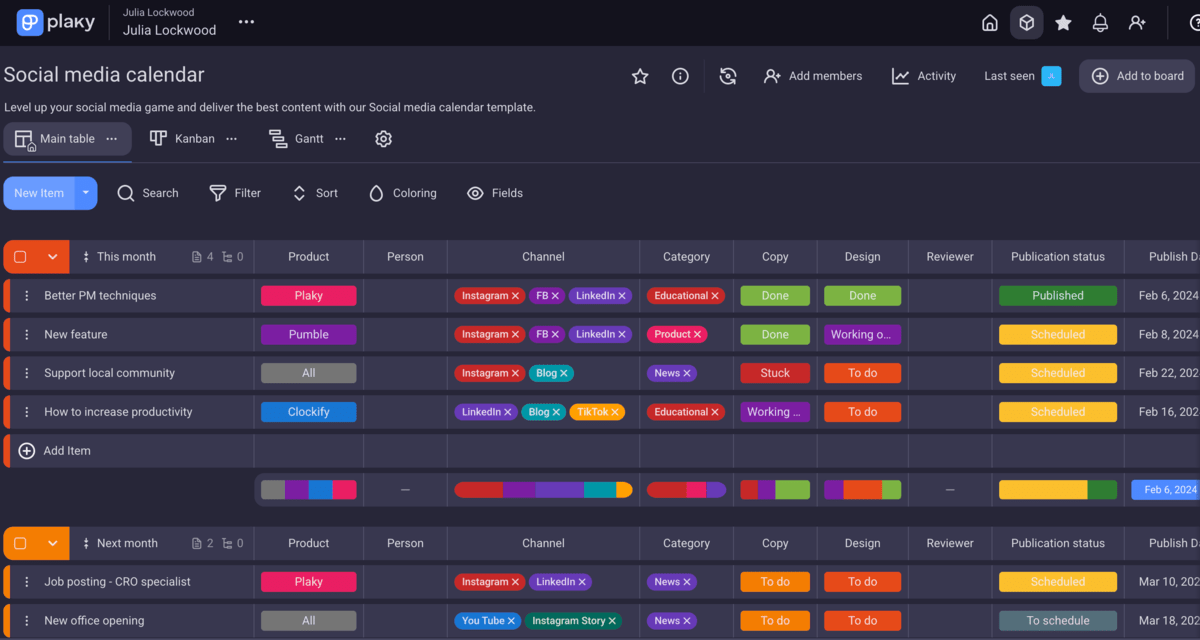
As you can see, a customizable template like this one allows you to organize content for all your platforms. Not only will this save you time, but it will also decrease your chances of giving up midway through due to frustration.
In case you would like to be the creator of your own calendar, skip this step and have a look at the next one.
#2 Start from scratch
Creating your own social media calendar is effortless with Plaky — you can do it in 3 easy steps:
- Dedicate a task for each piece of content — Choose a new board from the drop-down menu and opt for Create from scratch. Next, simply name your board and add new items to specify your tasks within the board.
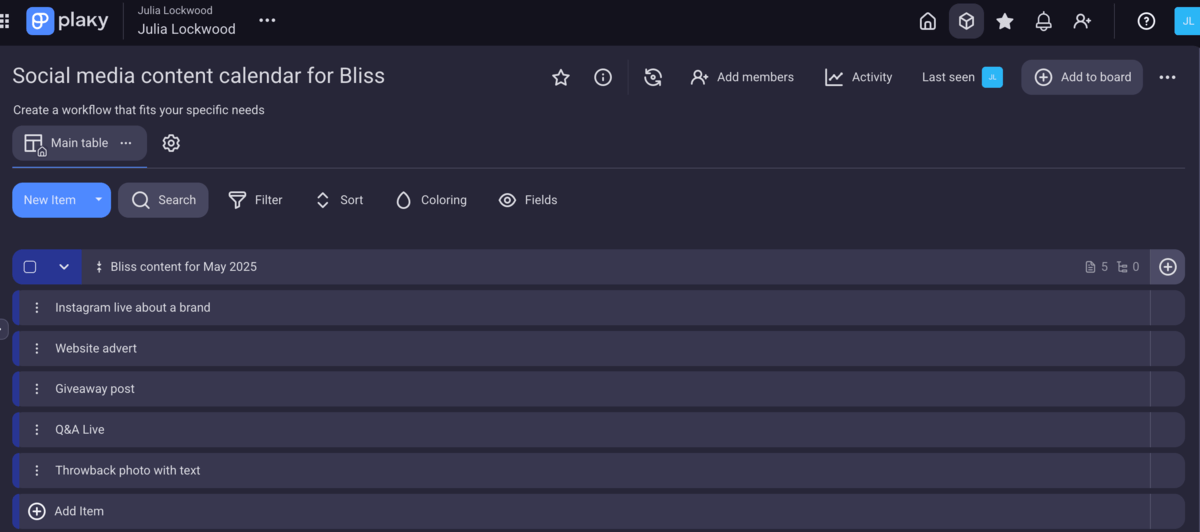
- Assign team members to tasks (if you work with a team) — Add a Person field and type in the names of team members who will take on a particular task. Plaky will later offer those names within a list, allowing you to easily choose the right person.
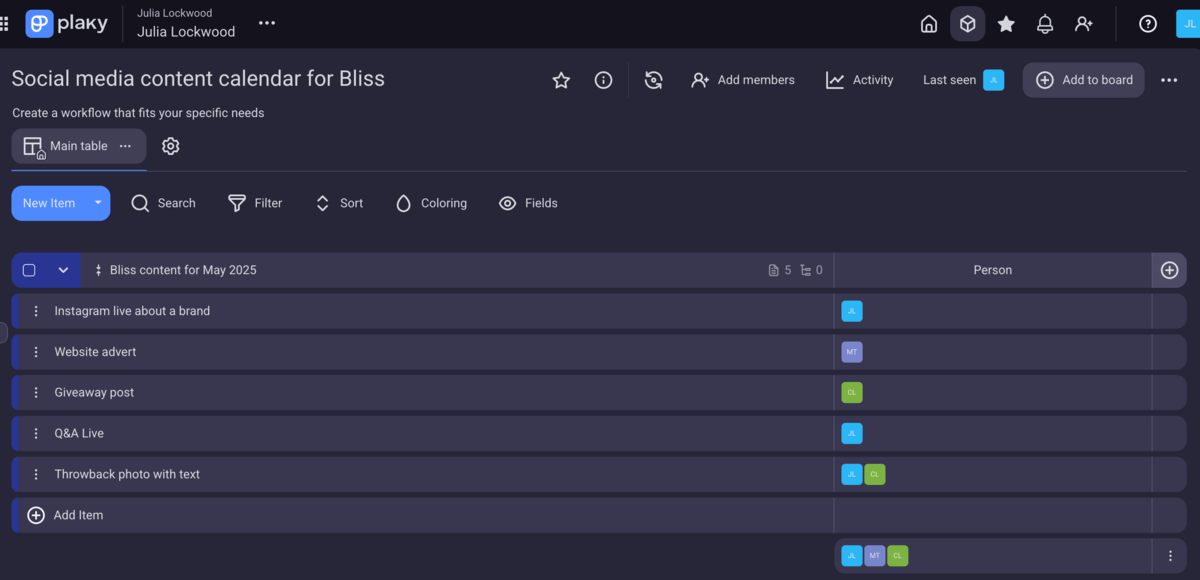
- Categorize your tasks — Use other fields to add important information, such as tags, statuses, deadlines, descriptions, links, labels, etc.
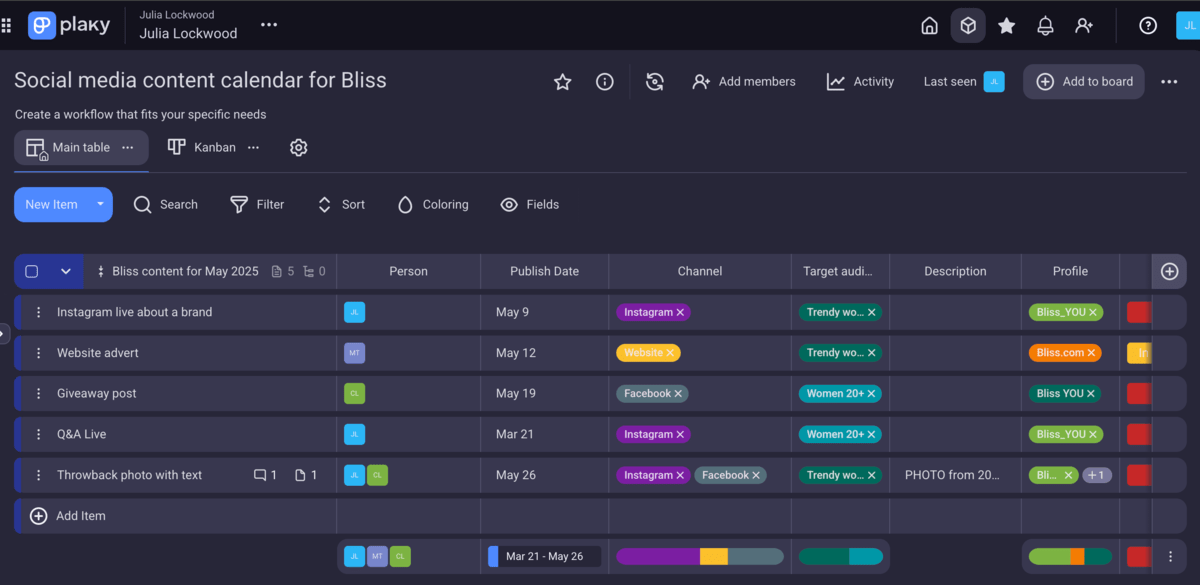
Keep in mind that your calendar should be uniquely yours and contain the information that you need it to contain. After all, its main purpose is to be an organizational aid to help you stay on top of your posting schedule.
#2 Determine what will go into your social media calendar
A social media content calendar will look different for everyone. It can be a detailed plan or a simple roadmap for your future posts. Of course, if you want to make the best use of it, you should consider being as detailed as possible.
The goal is to have everything planned out — so that you can spend as little time as possible working on the content on the day of posting.
Here’s a great example of a task in Plaky’s social media calendar with all task-specific information localized to its individual task card.
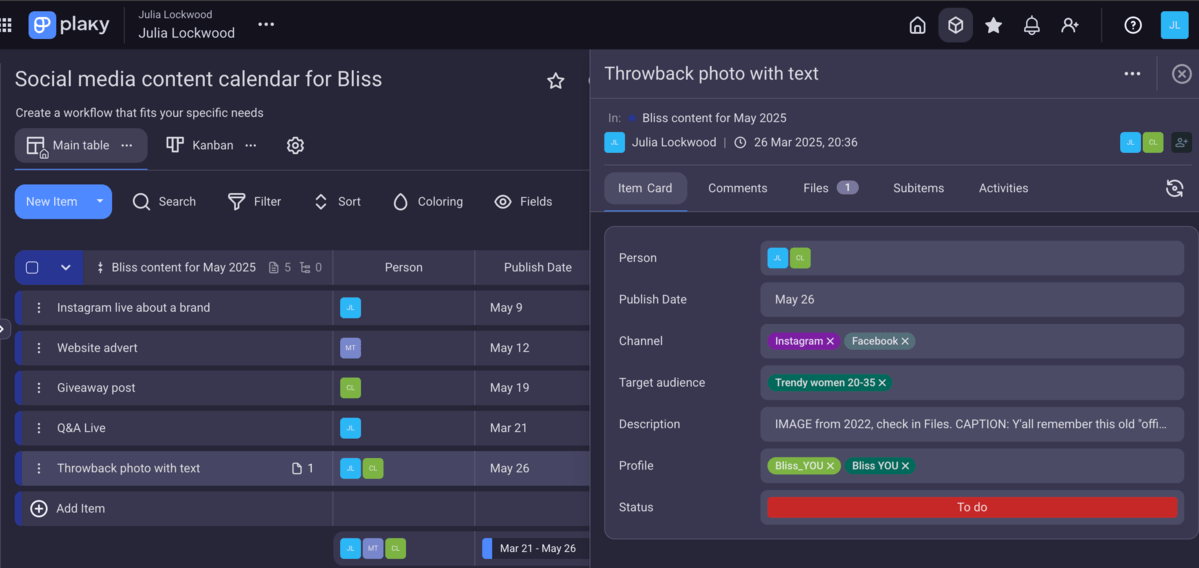
#3 Remember the 80/20 rule
If you’re using your social media profiles to market a product or service, the 80/20 rule states that you should focus on content that adds value to the customer 80% of the time, and spend only 20% on promotions.
This actually makes sense. After all, people spend time on social media for entertainment purposes — no one wants to look at ads in their spare time.
And, while you’re at it, make sure to mix up the rest of your content too. E.g., if you posted a how-to post yesterday and the day before, it might be time for something different.
Keep the content interesting, and keep it new. You’d never go to work in the same outfit for a week straight. So, it makes no sense to “dress” your profile with the same posts over and over again. It will get stale before you know it!
#4 Review and get feedback
The great thing about content calendars is that they allow you to review and tweak your future posts if you notice a flaw or typo. You can even show it to people you trust to get their honest opinion before you post.
This will result in better-quality content — and might even point out some of the quirks, ticks, or gestures that you didn’t know you had, but might want to cut back on.
Tips for creating captivating social media posts
This post wouldn’t be complete without a few tips that will help you polish your social media posts and make them stand out.
#1 Find your style
Just like you can recognize painters by their unique painting styles, your social media profiles should be a reflection of yourself.
To create a recognizable brand, make sure to come up with a uniform:
- Font,
- Color palette,
- Picture style, and
- Tone of writing.
#2 Recycle posts
Managing several different social media accounts is challenging and time-consuming even with a marketing team to back you up. Creating unique content for each account is neither smart nor sustainable. This is why having a detailed plan with a timeline for posting is a lifesaver.
Also, don’t be afraid to recycle posts.
The best way to go about social media marketing is to have one primary platform for which you will create high-effort and long-term content. This content should later be used to feed your secondary accounts and platforms.
For example, with YouTube videos, you can:
- Cut them up and create Instagram Reels or TikTok videos,
- Highlight the most striking information and turn it into a series of X posts,
- Take your script, clean it up, and make a blog post out of it, and more.
Remember — always work smarter, not harder.
#3 Be consistent
In the world of social media, consistency trumps frequency.
This means that, even if you post only twice a week, as long as you do it consistently, over a long period of time, you will begin to see results.
Ideally, however, you should post at least once every day to take maximum advantage of the exposure social media offers.
Keep all your old and future posts in Plaky
#4 Make use of every tool in the platform’s arsenal
Social media platforms are constantly being updated, and new features keep popping up.
Short videos are still the main trend on social media, but longer forms are becoming more and more popular. For example, several months ago, YouTube announced that after October 15, 2024, their short videos could be up to 3 minutes long.
An interesting fact about new features on social media is that the platform actively encourages you to use them. In other words, the platform will reward those who popularize the new features with greater exposure.
So, if you really want to make it on social media, use everything it has to offer.
#5 Keep up with trends
Riding trends is a great way to gain traction on social media. You’ll often notice videos from completely unknown profiles go viral simply because they were early to the party.
So, keep up with the trends, read the news, and catch the trends in their early stages — for the greatest impact.
#6 Make use of international holidays
Yes, popular holidays like Christmas, New Year’s Eve, or Valentine’s Day are all great opportunities for creative content.
Also, you can put your creativity to test with some unusual holidays, such as Towel Day or Talk Like a Pirate Day. And, no, we’re not joking (they’re celebrated on May 25 and September 19, respectively).
But did you know that there’s a holiday for nearly every day of the year?
In the table below, we highlighted some of the holidays you might find interesting and could even use in one of your future posts:
| Holiday | Date |
|---|---|
| Global Family Day | January 1 |
| International Thank-You Day | January 11 |
| World Thinking Day | February 22 |
| World Water Day | March 22 |
| Earth Day | April 22 |
| World Book Day | April 23 |
| World Day for Cultural Diversity | May 21 |
| World Bicycle Day | June 3 |
| International Yoga Day | June 21 |
| World Snake Day | July 16 |
| International Lefthanders Day | August 13 |
| International Chocolate Day | September 13 |
| World Farm Animals Day | October 2 |
| World Toilet Day | November 19 |
| International Volunteers Day | December 5 |
#7 Engage with your audience
Think about it — a major reason people love social media is that they can get advice from or chat with the people they follow and admire.
Engaging with your audience will allow them to connect with you on a deeper level. This will create trust, and, even more importantly, loyalty — which will keep them coming back to you and your brand instead of millions of others out there.
Communication is one of the most important aspects of any business, especially in social media marketing.
It is called social media, after all.
Support your social media growth with Plaky
Content calendars bring the structure social media marketers need to juggle multiple platforms effectively and grow as a brand.
With Plaky, you can have your social media content organized and labeled so that you always know when, what, and where to publish.
If data in your calendar gets overwhelming, just use sort or filter options to better organize your board and get a clearer overview of important items.
Another cool thing that you’ll love while managing a content calendar is conditional coloring — you can color-code tasks with deadlines approaching and ensure timely publishing.
But, that’s not all.
In case you have your own team of social media specialists, you can easily:
- Upload and share files of various formats,
- Assign tasks to your team members,
- Communicate within tasks with your team via comments and @mentions, and
- Keep everyone in the loop at all times.
Plaky gets your team together in one centralized place so that everyone involved is always on the same page. This improves team efficiency and leaves more time for creative efforts.
Plus, Plaky helps you and your team stay up-to-date with notifications. You and your team members can always receive real-time updates about changes made to items and boards.
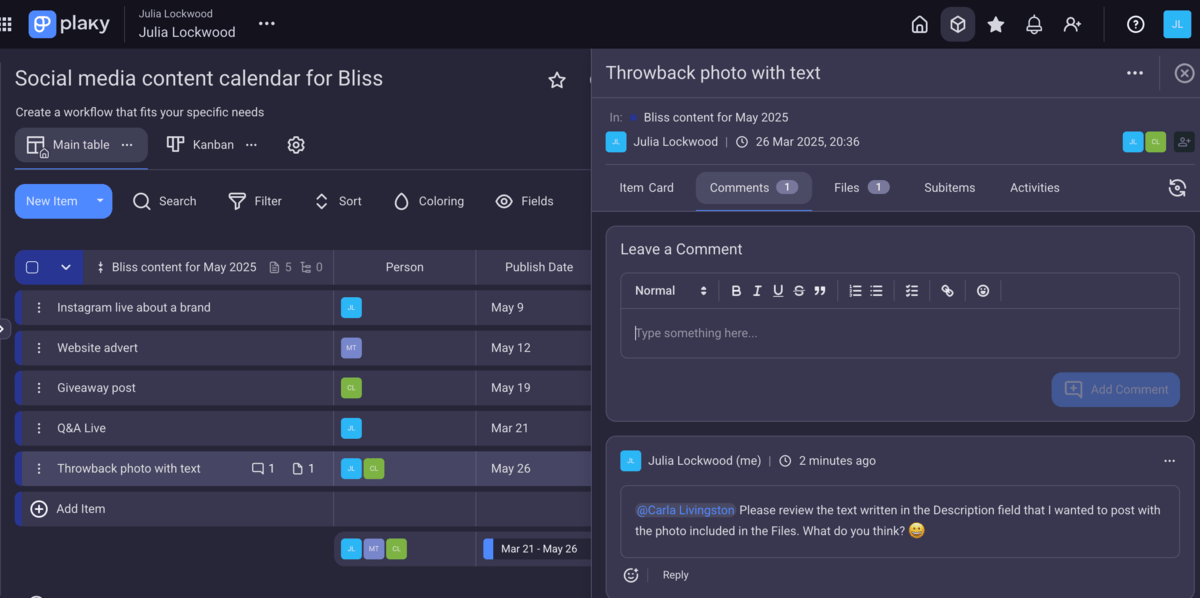
In addition to all these features, Plaky enables you to see your social media content calendar in 2 views:
- Kanban view — Use it to see your tasks as cards that you can reorder and filter by priority or status, and
- Gantt view — Use it to check if any tasks on your calendar overlap and spot roadblocks on time.
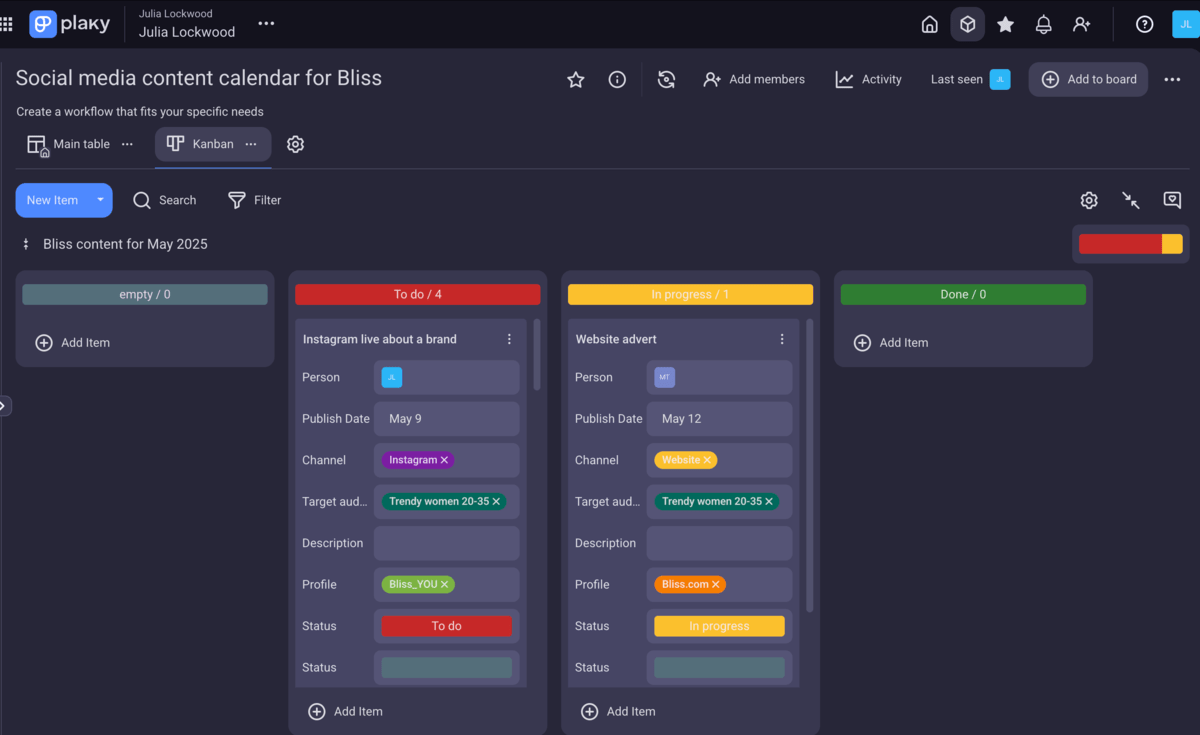
Another great thing about Plaky is that it’s cloud-based. So, if you need to make changes to your existing tasks to follow a trend, add new ones, or check task statuses — Plaky’s got your back anytime and anywhere.
Create your social media content calendar in Plaky and watch your social media profiles soar. Sign up for a free Plaky account today!

